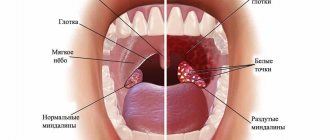Probably every mother has at least once encountered such an alarming and painful symptom in a child as redness of the throat. This fact can mean many different diseases: from mild respiratory diseases to serious infectious ones. It is known that redness of the throat in any case is caused by viruses or bacteria, and the doctor’s task is to find out which microbes attacked in this case and prescribe treatment appropriate to the diagnosis.
A red throat causes a child many unpleasant sensations: it hurts, it’s sore, itchy, and it becomes painful for the baby to eat and talk. From the article we will learn what causes redness of the throat, and we will find out how and with what to treat a red throat in children of different ages. We will also find out what pediatrician Komarovsky thinks about treatment.
Causes
When foreign pathogenic bacteria invade the mucous membrane of the throat, with a weakened immune system, the mucous membrane becomes inflamed, swollen, and blood flows to it from the inside to “strengthen” the defenses. As a result, we can observe with the naked eye a red, slightly swollen, loose throat in a child. What are the reasons for this condition?
Pharyngitis, tonsillitis and other infectious diseases of the upper respiratory tract. Respiratory ailments and influenza.
Sometimes a red throat can also be caused by chickenpox. But, usually this disease is diagnosed by characteristic rashes on the skin.
Such serious and dangerous “childhood” diseases as measles, rubella and diphtheria will also inevitably lead to redness of the throat.
Diseases of the digestive system may be the culprits of this symptom. For example, gastrodudenitis in the chronic phase or dyskinesia.
In infants, redness of the throat (although not critical) can cause teething.
In children with weak immunity, the throat may become red, swollen and sore even when inhaling polluted, dusty air, as well as after a long stay in a room with dry air.
On video, how to treat a red throat in a child:
As you can see, the causes of this symptom are quite varied. To find out the exact details, you need to visit a doctor and undergo an appropriate examination. This is a necessary condition and the key to the baby’s successful recovery.
This article will help you understand why a burning sensation occurs in the throat area, and what means can be used to get rid of this problem.
But this article explains why the throat is choking, and what the main reasons may be for this.
How snot in the throat is treated, and what the best and most popular remedies are, is described in this article: https://lechim-gorlo.ru/g/lechenie/kak-izbavitsya-ot-soplej-v-gorle.html
Maybe
If your throat is red but doesn't hurt
In such a situation, when the throat is red but does not hurt, it is still better to start treatment with at least herbs (gargling). Solutions of salt and soda are also effective. It is always better to start treating the disease in the early stages, rather than waiting for it to spread and take on more severe forms.
Catarrhal sore throat
The throat may be red, but not painful, with catarrhal tonsillitis. This type of sore throat is milder in nature - the tonsils are only slightly affected. There may or may not be a sore throat.
Other symptoms: • enlarged cervical lymph nodes; • sometimes – increased body temperature; • general lethargy, inability to work. • tonsils are slightly enlarged in the palate; • mild difficulty swallowing food and saliva.
Causes of catarrhal tonsillitis: • infectious; • hypothermia; • lack of vitamins.
Laryngotracheitis
If a child’s throat is red, but does not hurt, then this may be a signal of laryngotracheitis. A distinctive symptom of the disease is loss of voice.
Other symptoms: • barking cough; • shortness of breath; • unpleasant sensations in the throat – scratching, tingling.
Treatment: • compliance with the voice mode (silence); • herbal and oil inhalations (see below); • warm drink.
Treatment
Let's find out how to treat a sore throat in children of different age categories. We provide general recommendations here, since the doctor will prescribe the exact treatment based on the corresponding specific diagnosis.
Infants
In this case, everything is complicated by the fact that the baby’s body is weak, and he simply cannot take many medications. For infants, it is good to use traditional methods of treatment, which will safely and gently contribute to the main therapy. But be sure to first consult with your doctor about any home treatment you choose.
A warm compress with a decoction of chamomile or calendula has a good effect. The compress can even be left on for an hour and a half while the baby sleeps. Attention: if the redness of the throat is associated with swelling, warm compresses cannot be applied: they can contribute to the rapid development of swelling of the laryngeal mucosa.
Warmed low-fat cottage cheese can also be used as a soft compress. This product warms the throat well and is safe.
It is good to give your baby weak chamomile tea, but only after the doctor approves this intake. Chamomile is known for its antiseptic and anti-inflammatory properties, and it is also very gentle and safe.
If a child sucks a pacifier, it won’t hurt to lubricate it with an oil solution of chlorophyllipt from time to time. This safe drug is approved even for infants, and helps to quickly eliminate the infection.
When giving your child a bath, add a weak decoction of eucalyptus leaves to the water. This technique will have a bactericidal and immunomodulating effect.
You can place peeled onion and garlic cloves in your child’s room. The volatile phytoncides of these spicy vegetables can cleanse the air of many pathogenic bacteria.
Regularly humidify the air in your child's room, especially in winter when the heating radiators are turned on. This technique will help eliminate discomfort when swallowing, remove soreness and dryness.
To raise a child’s immunity to the required level, you can give him drugs with interferon (Anaferon), which naturally strengthen the body’s defenses.
Anaferon for a child
Children from one to three years old
Most of the advice from the previous age point is also suitable in this case. But there are also more specific recommendations.
In case of an inflammatory infection (sore throat, pharyngitis, gingivitis), the drug Lizobact will help the child (this article describes the difference between Faringosept and Lizobact). Efizol helps well with infectious inflammation. But only a doctor should prescribe these drugs.
Efizol for a child
Irrigation of the throat with appropriate sprays will do a good job. Inhalipt and other drugs of this type help quite well. Attention: the spray should not be sprayed directly into the baby’s throat, but onto the inside of his cheeks. This precaution is necessary to prevent the child from choking on the liquid stream of aerosol.
Ingalipt for a child
To soften irritated mucous membranes, you can lubricate it with oil solutions of chlorophyllipt, sea buckthorn oil or eucalyptus oil. Rosehip and propolis oils are also great. The composition is applied to a gauze swab, which is used to carefully treat the throat mucosa. But how to properly use Ingalipt spray for children is described in this article.
A compress in the form of a cabbage leaf will help “draw out” the infection and alleviate the child’s condition.
Monitor the level of air humidity in the room: dry air aggravates all unpleasant symptoms and causes a sore throat. Let your baby drink more warm liquids, which will moisturize the mucous membranes and help remove toxins from the body.
Older children
If a red throat is caused by an inflammatory infection (pharyngitis, tonsillitis, laryngitis), an older child can be given the drug Theraflu, which can quickly alleviate the condition.
If the disease is caused by a bacterial infection, antibiotics prescribed by a doctor are used.
The following are recommended:
- Tsiprolet;
Tsiprolet for children - Antibiotic Amoxiclav for sore throat;
Amoxiclav - Flemoxin (This article describes how Flemoxin Solutab is used for sore throat in adults);
Flemoxin - Sumamed (But Sumamed is used for sinusitis in children, described in detail in this article).
Sumamed
Antibiotics are most often given to a child orally, however, in some cases they may be administered intramuscularly or intravenously. Typically, this method of treatment is prescribed if the child’s condition is very serious and the illness is serious.
Gargling with special saline solutions, homemade decoctions of medicinal herbs, soda and furatsilin solutions will have an antibacterial effect, eliminate microbes accumulated in the throat, and help relieve inflammation.
If the child’s temperature does not exceed 38 degrees, then there is no need to bring it down. And if it exceeds, give your baby safe antipyretics: Panadol, children's Paracetamol.
Panadol
It is good to give your child a warm drink. Warmed milk with honey is especially useful for redness of the throat. This drug can be given only if the child is not allergic to honey. It is also useful to give warm cocoa with milk. You need to put a piece of butter in the drink to soften the throat. Cocoa should be drunk before bed: it, among other things, also helps you fall asleep quickly.
Lugol's solution is suitable for lubricating the throat of children of the “older age category”. For the procedure, you need to moisten a gauze swab in the solution, and then carefully, but carefully, treat the mucous membrane of the throat with it. Lugol's solution can also be used for rinsing. Before use, we recommend that you read the instructions for Lugol spray for children.
Lugol's solution for children
For a faster recovery, you need to use special aerosols to irrigate the throat.
The following drugs are suitable:
- Tantum Verde;
Tantum Verde for children - Hexoral (read how to be treated with Hexoral);
Hexoral - Miramistin et al.
If redness in the throat is associated with pain, you can give your child lozenges and lozenges. Children love this sweet treatment very much and stick to it with pleasure.
Suitable medicinal lozenges include:
How are they treated?
Treatment is always prescribed after determining the cause of the disease and the characteristics of its course. How to treat a sore throat? The main principles of therapy are rinses, warm compresses, and general rest.
Drug treatment is prescribed after a series of tests:
- throat smear (the genus of bacteria and their resistance to drugs are determined);
- laryngoscopy (visually assesses the condition of the respiratory tract mucosa);
- blood analysis.
Mild and moderate degrees of the disease can be treated at home and do not require hospitalization. Simple rinses help relieve swelling and remove purulent plugs from the tonsils. Antiseptic drugs have analgesic and anti-inflammatory effects. The most effective of them: Tantum Verde, Stopangin.
Antibacterial agents are used in severe cases of the disease. Doctors prescribe aminopenicillin and cephalosporin antibiotics. Drugs such as Cefaclor, Cefadroxil along with clavulanic acid are used. The dosage and period of use are determined by the attending physician individually depending on the age, weight and chronic diseases of the child. You cannot independently replace a drug prescribed by a doctor due to its high cost or an allergic reaction.
Gargling with saline solutions and herbal infusions helps relieve throat discomfort. Recipes for natural-based rinses that will help you recover faster:
- Tincture of calendula. It performs an antibacterial function. To obtain a solution, add 1 spoon of tincture to a glass of warm water. Regular rinsing up to 6 times a day reduces the symptoms of inflammation in the tonsils. You can harden your throat by constantly lowering the temperature of the gargling water.
- Brine. The product has a bactericidal effect and also promotes the drainage of pus from the tonsils. The solution is prepared as follows: 1 tsp. table salt and a drop of iodine are diluted in a glass of water.
For a loose throat, physiotherapeutic procedures are appropriate, with the help of which you can achieve recovery without resorting to surgery. The most effective physiotherapeutic techniques:
- Ultrasound and laser therapy. The procedures accelerate the outflow of pus from the lacunae of the tonsils. The duration of the treatment course is 1-2 weeks.
- Vacuum is prescribed to children who have purulent plugs in the tonsils. Using low-frequency ultrasound, pus is sucked out of the tonsillar lymph nodes. After the procedure, be sure to rinse your throat with antiseptics and antibiotics. To consolidate the therapeutic effect, low-frequency phonophoresis is recommended for children. The course of treatment lasts at least 2 weeks.
Surgery on the tonsils is performed when foci of chronic infection in the throat lead to disruptions in the functioning of other organs and systems. Surgical intervention is also indicated when conservative methods do not bring a positive result.
Komarovsky's opinion
Let's find out what the famous doctor Komarovsky says about the treatment of red throat in children.
The pediatrician claims that almost 90% of all cases of redness of the throat in children are in one way or another associated with ARVI. However, a dry nose with a red throat means the onset of a bacterial infection such as a sore throat or even diphtheria.
The doctor does not advise making any independent diagnoses. And, even more so, he is against self-prescribed treatment for the child. A red throat can be caused by various diseases, so only a doctor can make a competent diagnosis.
Komarovsky names too dry indoor air as one of the most common causes of redness in a child’s throat. Sometimes, when this external sign is eliminated, the redness in the baby’s throat also disappears. The doctor recommends using a humidifier in the children's room, considering this mechanism an invaluable assistant in the fight for the child's excellent well-being.
Video opinion of Dr. Komarovsky:
The doctor categorically does not advise lowering the temperature if it does not exceed 37 degrees. Even an increase to 38 degrees is a completely natural physiological reaction of the body, which is better not to interfere with. A non-critical increase in temperature indicates that the baby’s immunity is working and that the body’s defenses are not asleep. The high temperature, of course, needs to be lowered.
If a red throat is caused by the development of a bacterial infection in the body, it is strictly forbidden to treat the child with traditional methods. And, moreover, make them the main means, consider them a panacea. Bacterial inflammatory processes are very serious and are fraught with serious complications. To eliminate them, antibiotics and constant medical supervision are required.
Angina
Sore throat (acute tonsillitis) is a group of infectious diseases characterized by damage to the lymphoid tissue of the pharyngeal tonsils. The palatine tonsils are most often affected. The main causes of sore throat: • development of infection from an internal source due to decreased immunity (for example, after hypothermia). Sore throat is often preceded by inflammation in the nasopharynx. Properly treated sore throat and runny nose will reduce the chances of developing a sore throat; • infection from a sick person or from a carrier of infection (including due to poorly washed dishes, through coughing with drops of saliva, from foods contaminated with staphylococcus); • exacerbation of chronic tonsillitis (usually due to decreased immunity).
The main symptoms of all types of sore throat: • sore throat; • weakness; • feeling overwhelmed; • increase in temperature (sometimes up to 39 degrees); • enlargement of the palatine tonsils; • tonsils are loosened and hyperemic. On their surface there are ulcers and plaques; • the nearest lymph nodes (cervical, submandibular) are enlarged and painful on palpation.
Types of tonsillitis: • catarrhal; • lacunar; • follicular; • fibrinous; • herpetic; • legmonous (intratonsillar abscess); • ulcerative-necrotic form (gangrenous); • mixed forms.
Acute sore throat (tonsillitis) takes 3-4 days to form. It is characterized by pathological rashes on the mucous membrane of the pharynx and tonsils.
Unlike acute tonsillitis, chronic tonsillitis is not characterized by changes in the tonsils .
The main manifestations of chronic tonsillitis: • high temperature; • sometimes – enlargement, redness of the tonsils, palatine arches; • general intoxication; • dizziness; • sometimes – loss of consciousness; • sometimes – nausea; • changes in stool.
Often chronic tonsillitis occurs under the guise of ARVI.
Differential diagnosis According to research, only in a third of cases enlarged tonsils indicate angina. There are many other diseases in which the tonsils also become enlarged, covered with plaque, and ulcers (diphtheria, Epshetain-Barr virus, etc.). It is necessary to examine and study laboratory data. It is impossible to make an accurate diagnosis without performing bacterial culture (isolating the causative agent of the disease from swabs from the nose and throat).
General Tips
For a sick child of any age (2, 3, 4, 5, 6, 7 years and older), bed rest and staying in a calm environment are extremely important. It is necessary to exclude irritating dishes from the baby’s diet: too sweet, salty, sour, spicy.
The entire diet should be fresh and soft in consistency so as not to make swallowing difficult. Force-feeding is not recommended: very little food is required to maintain the body, and with a sore throat, any sip can cause severe pain to the child.
We examined the features of such an unpleasant symptom as a red throat in children. The causes of this phenomenon are varied, so treatment should be prescribed by a doctor after a thorough examination. By following all the doctor’s instructions and following the advice from our article, you will definitely be able to quickly help your baby.
Activities after recovery
Rehabilitation therapy after throat diseases includes the following measures: • gentle daily routine; • diet; • correct temperature conditions (excluding hypothermia and overheating); • for schoolchildren and children attending nursery (kindergarten) – home regime for a week; • taking vitamins (Multitabs, Vitrum, Kinder Biovital, etc.), course – 1 month; • taking medications to restore intestinal microflora (Linex, Bifiform, Acipol, yogurt in capsules); • strengthening the immunity of the oral mucosa (imudon).









